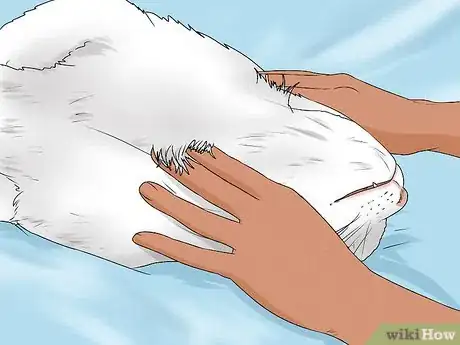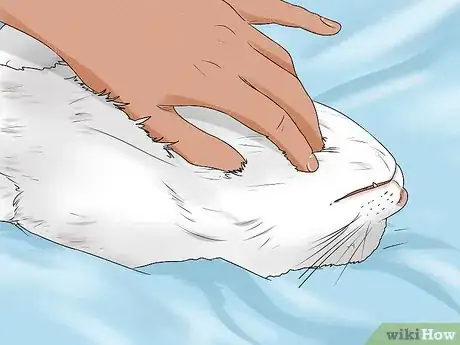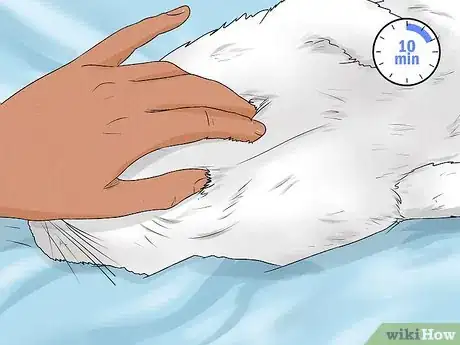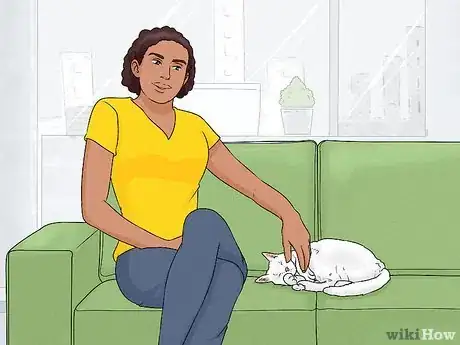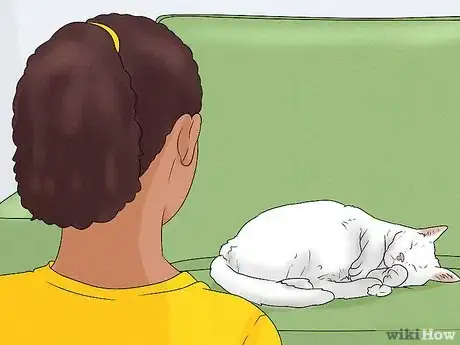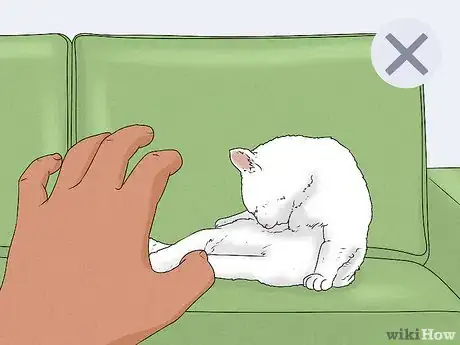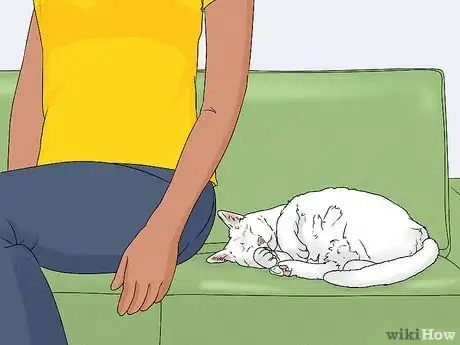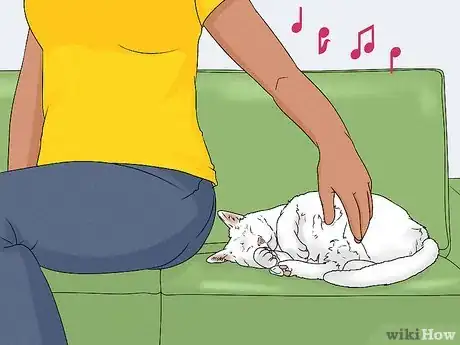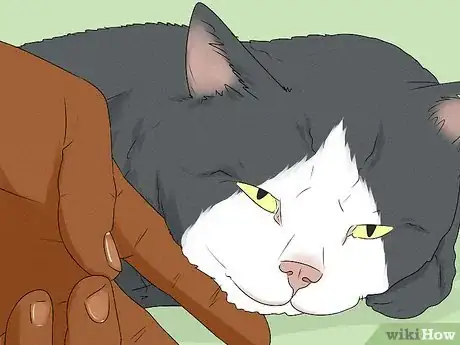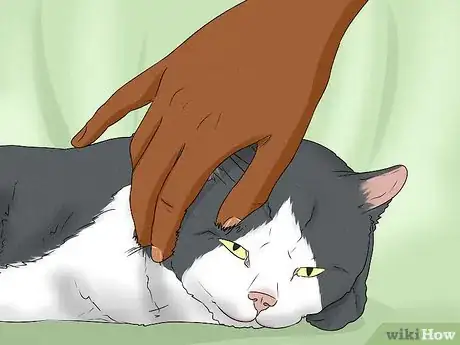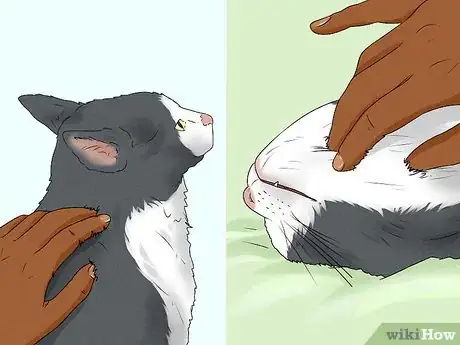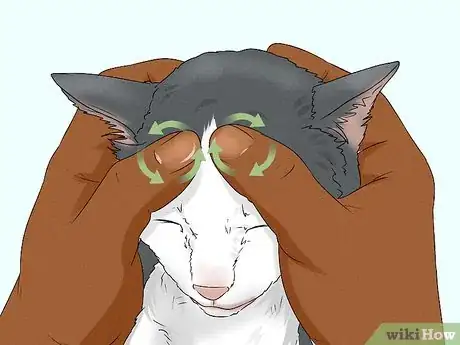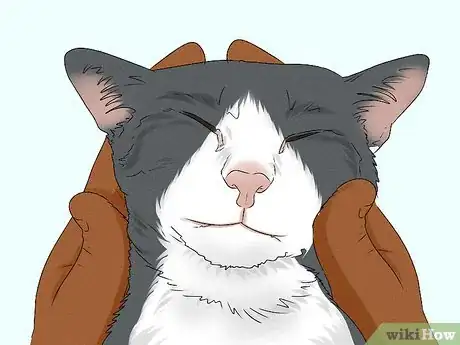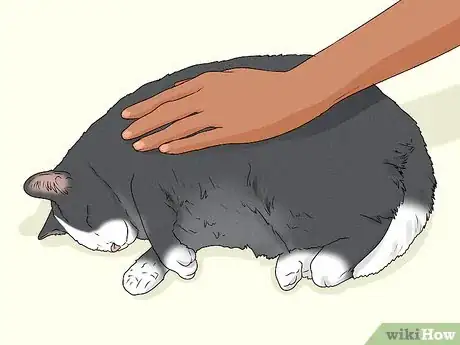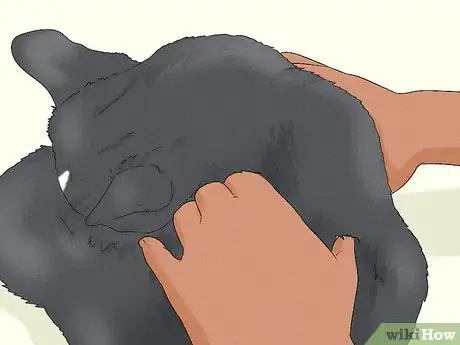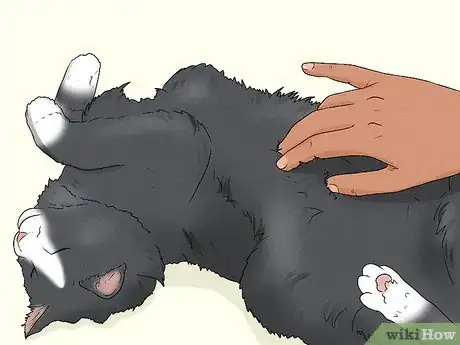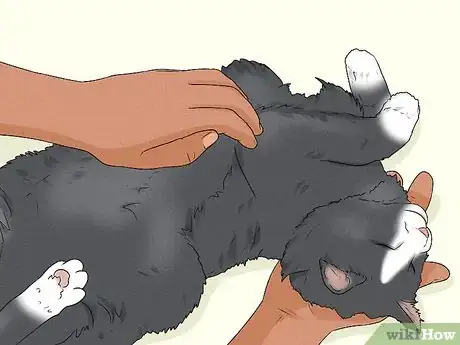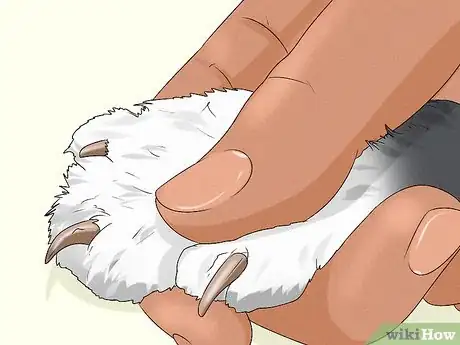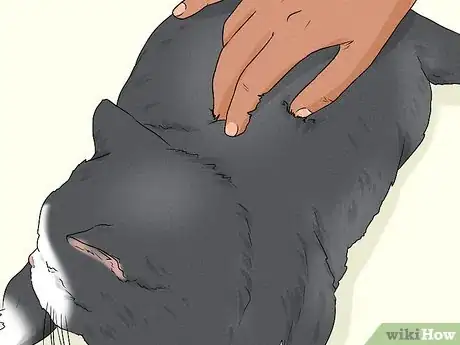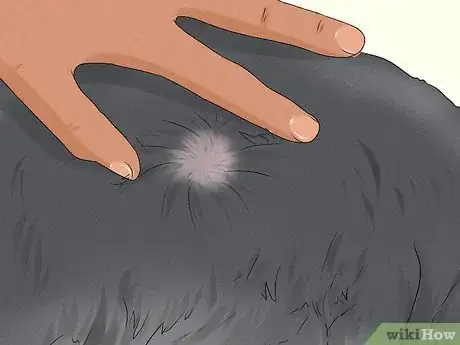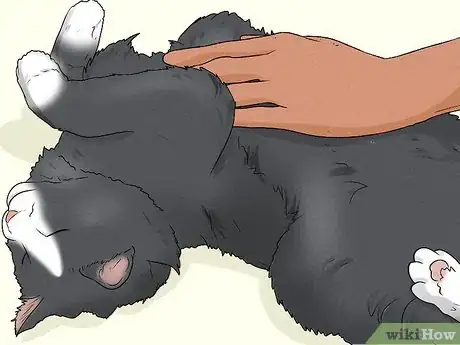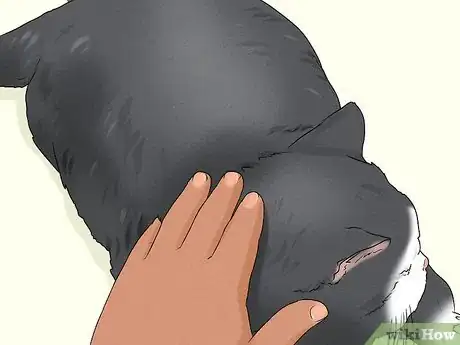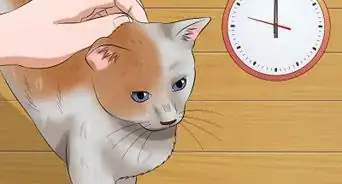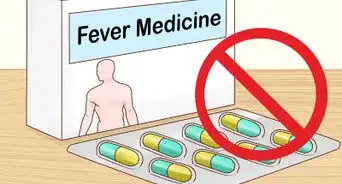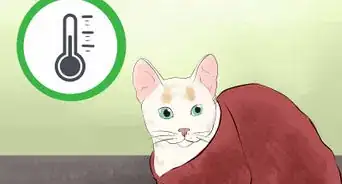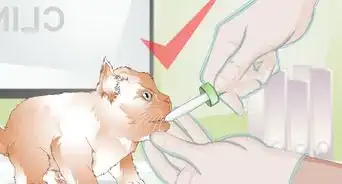This article was co-authored by Molly DeVoss and by wikiHow staff writer, Hannah Madden. Molly DeVoss is a Certified Feline Training and Behavior Specialist (CFTBS), a Certified Cat Behavior Consultant (CCBC), a Fear Free Certified Trainer (FFCT), and the Founder of Cat Behavior Solutions. Molly specializes in using positive reinforcement to modify and prevent unwanted behaviors in cats and reduce cat shelter surrender. Molly has sat on the Dallas Animal Advisory committee since 2013 and was voted one of the Top 12 Extraordinary Cat Behaviorists of 2020 by Catpetclub.com. She is certified by both the Animal Behavior Institute and the International Association of Animal Behavior Consultants. She is also the host of the weekly podcast Cat Talk Radio.
There are 12 references cited in this article, which can be found at the bottom of the page.
wikiHow marks an article as reader-approved once it receives enough positive feedback. In this case, 92% of readers who voted found the article helpful, earning it our reader-approved status.
This article has been viewed 220,493 times.
Massaging your cat can make your favorite furry creature feel relaxed, calm down after a stressful event, and just feel more loved and cared for. In fact, if done correctly, massaging your cat can make your kitty feel much better than from just regular petting. Try this bonding technique whenever your kitty needs a pick me up or you want to connect with your furry friend.
Steps
Preparing for a Cat Massage
-
1Give your cat a massage to relieve stress. Just like when you go get a relaxing massage, your cat can enjoy one, too. A gentle massage does wonders to help lower anxiety, relieve tension, and relax your cat’s muscles after a hard day. Plus, it can strengthen the bond between you two.[1]
- If your cat is old or sick, a massage can help them fall asleep, too.
-
2Stick to light stroking when you give your cat a massage. Think about how your cat likes to be petted: usually, they enjoy soft, light touches that run along their body. As you give your cat a massage, stick to gentle motions that caress them rather than deep ones that could be tough on their bodies.[2]
- If you think your cat needs a deeper massage, you can take them to a vet to get it done professionally.
- As you move throughout the massage, you can use one or both of your hands.
Advertisement -
3Keep the massage around 5 to 10 minutes. Cats don’t need hours and hours of massage, so you can keep yours short. Set aside at least 10 minutes of your day to give your cat some extra attention whenever you have the time.[3]
- There’s no set amount for how often you should massage your cat, so you can tailor it to their needs. In general, try not to give them a massage more than once or twice per day.
-
4Massage your cat when they’re in the right mood. If your cat is grumpy, anxious, or jumpy, they might not be in the mood for a lot of touch. Wait until your cat approaches you with some gentle head bumps to indicate they’d like to be petted, then go ahead with the massage.[4]
- Never massage your cat if they’re in a lot of pain, if they have open wounds, or if they have blood clot problems. You should also never perform a massage directly on top of tumors or infected skin.[5]
-
5Get yourself into a zen mood. Cats can pick up on your stress and anxiety, and they won’t be able to relax if you’re in a bad headspace. Make sure you’re feeling at least somewhat calm before you start giving your cat a massage so they can feed off of your positive energy.[6]
- Giving your cat a massage can be a relaxing activity for you, so you can use it to help you destress after a tough day.
- If you aren’t in a good mood, your cat may not want to be petted by you at all, anyway.
-
6Find a comfortable spot. This is all about making your cat more relaxed, so you should pick a space where they feel their best. You can sit on the couch, lay on the floor, or stand up next to a table—whatever your cat prefers.[7]
- Make sure there aren’t a ton of loud noises (from kids, other pets, or TVs) so your cat can stay calm and relaxed.
- You should also keep the temperature neutral—not too hot and not too cold.
Making Your Cat Comfortable
-
1Wait until your cat isn’t busy. It might sound funny, but cats have lives too! If your cat is grooming themselves, eating, or using the litter box, it isn’t a good time for a massage right now.[8]
- Try to wait about 2 hours after your cat eats before you start a massage. That way, they can digest their food first.
-
2Make sure your cat is comfortable around you. Get close to your cat and make sure that he's happy to be in your presence. You may even want to wait for him to come to you instead of grabbing him out of his comfort zone. Wait for him to hang out with you, relax, lie down, or even to purr or nuzzle up against you.[9]
- If your cat isn’t approaching you or doesn’t want to be touched, they probably aren’t in the mood for a massage right now.
-
3Talk or sing to your cat. Make your kitty feel calm and happy by getting them into the right state of mind first. Start by singing lightly to your cat or using a low, calming voice and telling your kitty that he's a good boy.[10]
- You know what your cat likes best, so stick to what you know!
Starting the Massage
-
1Start slow at your cat’s favorite spot. Pick your cat’s favorite spot, whether it’s under the chin, on their back, or behind the ears. Starting with a familiar place will make your cat more amenable to being massaged all over.[11]
- You can figure out where your cat likes to be touched by listening when they start to purr.
- It’s super important to start slow—going too fast can overwhelm your cat and make them anxious.
- Try to stay away from the head and face unless your cat really likes that. Cats can interpret that sort of touch as a threat, and it can stress them out.
- Cats typically prefer to be touched from the neck up.[12]
-
2Use your full hand to massage. Many people stroke their cats with their fingertips, but this touch might be too light for the cat to feel much, especially along the back or belly. Use your full hand and apply some gentle pressure to the cat’s body as you’re stroking it. Save your fingertips for massaging the head and face.[13]
- You can use just one hand or both hands.
-
3Monitor your cat’s reaction. Throughout the massage, pay attention to how your cat responds. If your cat keeps trying to get up, he might not be in the mood to get a massage. If they are blinking, purring, drooling, falling asleep, or even looking a little dazed, they’re probably enjoying the massage immensely.[14]
- If your cat backs up or starts to scratch you, stop the massage. It’s probably nothing personal, and you can try it again in a few hours or a few days.
- Some cats may raise their hind end when they're enjoying a massage, especially if you're petting them along the spine from their head to the base of their tail.[15]
Massaging Your Cat’s Head and Neck
-
1Use a circular motion on the top of your cat’s head. Most cats love to have their heads massaged. Starting at the top of your cat’s head, use the palms of your hands to go in a circular motion before moving onto the temples and cheeks. Use your fingertips to massage around and behind your cat’s ears, too.[16] [17]
- Pay attention to how your cat reacts to having their head massaged. Some cats perceive this as a threat, so back off if they look uncomfortable or anxious.
- You might want to come back to the head after you’ve massaged your cat more, since they might need to be more relaxed in order to fully appreciate having their head massaged.
-
2Massage your cat's chin and neck. After you've massaged your cat's head, rub under the cat's neck very slowly and gently. Massage your cat with your fingers, making small circular motions up and down the neck. Be careful not to press into their neck too hard to avoid hurting them.[18]
- The neck is another sensitive area, and your cat may not like it. Pay attention to their body language and how they act during this part of the massage.
-
3Use your fingers to massage your cat’s face. Use little circular motions with your fingers to massage his cheeks and his forehead. You can also use the palms of your hands on each side of his face. If your cat likes what you're doing, they may even let you massage the little area around the eyes, the nose, or the whiskers.[19]
- Cats rarely get touched on their faces, so getting massaged here can feel really good.
Massaging Your Cat’s Body
-
1Stroke your cat’s body from head to tail a few times. After you finish massaging his head and neck, give your cat a few firm pets on his body. Apply gentle pressure with your hand while you stroke him from head to tail. This will help his body relax into the rest of the massage.[20]
- Try to repeat each motion at least 6 times to really relax your cat.
-
2Massage your cat's shoulders. Start rubbing your cat’s shoulders in circles slowly. Place one hand on each of your cat's sides and give your kitty a good rubdown. Gently but firmly use both hands to knead the sides of your cat's body, especially his or her shoulders.[21]
- Your cat’s shoulders can get really tense after running around all day. A nice massage can free up that pressure and make them feel great.
-
3Stroke your cat’s back. Moving down the back from the shoulders, apply gentle pressure along your cat’s back and sides, using circular motions. Keep your attention on your cat’s upper back, as the lower back and hips can be sensitive for many cats. If your cat likes to be touched in this area, then massage it very gently.[22]
- Remember to pay attention to body language and purring.
-
4Massage your cat's belly. If your cat is relaxed enough, they might offer up their belly, too. Gently hold your cat with one hand and massage their belly with the other, kneading the skin gently. If they’re really relaxed, you can even use both hands to massage his belly.[23]
- Some cats really don't like to have their bellies touched, so do this carefully at first.[24] If your cat starts to hit you with their paws or stops purring, move onto a different spot.
- You can also mix it up, massaging your cat's belly with one hand while massaging his head or back with the other.
-
5Cup your cat’s chest to massage it. With your cat on their back still, use one hand to cup their chest while the other hand supports their head. Rub the palm of your hand in a circular motion to release the tension in the chest, just above the belly.[25]
- If your cat is relaxed enough, you can use your fingertips to gently massage the chest, too, working from the outside in.
-
6Massage your cat's tail. Start by massaging your cat's tail at the base, near the rump, and then slowly work your way toward the end of the tail. You can use both hands, but work lightly with the fingers, since the tail is a very sensitive place for the cat. If you just go for your cat's tail first, they’re likely to run away from you.[26]
- You can even massage your cat’s head with one hand and the tail with the other.
- If your cat starts wildly moving their tail, then they’re probably getting excited and maybe even angry, which is the opposite of what you want.
-
7Rub each paw in a circular motion. To finish off the massage, pick up one paw and place your thumb in the center of your cat’s paw pad. Slowly rub their paw in a circular motion as you apply gentle pressure, then move onto the next paw.[27]
- This is also called “pawflexology.”
- When you’re finished with the massage, you and your cat can cuddle together, have a nap, or enjoy some catnip.
- Massaging your cat's feet and toes while they're a young kitten makes the nail cutting process easier as they get older.[28]
Checking on Your Cat’s Health
-
1Check the health of your cat’s coat. While you’re massaging your cat, this is an ideal time to check your cat’s overall health. Check the fur to see if your cat has been grooming himself.[29]
- If the fur is matted or greasy, this could indicate health problems such as diabetes, bladder infections or other issues. If it seems unclean in only a few spots, this might indicate that your cat has trouble reaching certain areas of his body, perhaps because of arthritis.
- If the fur is over-groomed and the fur is actually missing or sparse in some areas, this could indicate a dermatological issue, such as a skin irritation or allergy.
-
2Check on your cat’s skin. As you rub your fingers and hands over your cat’s body, dig under the fur gently to check the health of your cat’s skin. If you feel bites or bumps, your cat might have fleas or other skin irritations. If you feel any abrasions or wounds, your cat might have an injury that you haven’t noticed yet.[30]
- If you do notice anything strange, take your cat to a vet to have them checked out.
-
3Feel the heat of your cat’s body. Cats can get feverish, which can indicate an illness of some sort. As you massage your cat, you will get a sense of his normal body temperature. If you feel that their body is warmer than usual, start checking for other indications of illness or injury, such as an infected cut or vomiting.[31]
- Heated spots on the body might also indicate arthritis.
-
4Feel for any lumps or other irregularities. Take note of any abnormalities that you might find as you massage your cat. Lumps and bumps can indicate serious health issues, so it’s good to be aware of what’s normal for your cat and what’s not.[32]
- If you think you’ve found a tumor, take your cat to the vet right away.
-
5Consult your vet if you find anything out of the ordinary. Your vet is the best source for assessing your cat’s health. If you’ve discovered a lump, skin problem or other health issue, ask your vet if the issue should be treated.[33]
- Take your cat to the vet regularly to check in on their health.
Expert Q&A
-
QuestionWhere's the best place to rub a kitten?
 Molly DeVossMolly DeVoss is a Certified Feline Training and Behavior Specialist (CFTBS), a Certified Cat Behavior Consultant (CCBC), a Fear Free Certified Trainer (FFCT), and the Founder of Cat Behavior Solutions. Molly specializes in using positive reinforcement to modify and prevent unwanted behaviors in cats and reduce cat shelter surrender. Molly has sat on the Dallas Animal Advisory committee since 2013 and was voted one of the Top 12 Extraordinary Cat Behaviorists of 2020 by Catpetclub.com. She is certified by both the Animal Behavior Institute and the International Association of Animal Behavior Consultants. She is also the host of the weekly podcast Cat Talk Radio.
Molly DeVossMolly DeVoss is a Certified Feline Training and Behavior Specialist (CFTBS), a Certified Cat Behavior Consultant (CCBC), a Fear Free Certified Trainer (FFCT), and the Founder of Cat Behavior Solutions. Molly specializes in using positive reinforcement to modify and prevent unwanted behaviors in cats and reduce cat shelter surrender. Molly has sat on the Dallas Animal Advisory committee since 2013 and was voted one of the Top 12 Extraordinary Cat Behaviorists of 2020 by Catpetclub.com. She is certified by both the Animal Behavior Institute and the International Association of Animal Behavior Consultants. She is also the host of the weekly podcast Cat Talk Radio.
Certified Feline Training and Behavior Specialist & Certified Cat Behavior Consultant Certified Feline Training and Behavior Specialist & Certified Cat Behavior ConsultantExpert AnswerTry rubbing your kitten's toes and paws. This way, you'll have an easier time time trimming your kitty's nails once they're an adult.
Certified Feline Training and Behavior Specialist & Certified Cat Behavior ConsultantExpert AnswerTry rubbing your kitten's toes and paws. This way, you'll have an easier time time trimming your kitty's nails once they're an adult. -
QuestionWhere's the best place to rub a cat?
 Molly DeVossMolly DeVoss is a Certified Feline Training and Behavior Specialist (CFTBS), a Certified Cat Behavior Consultant (CCBC), a Fear Free Certified Trainer (FFCT), and the Founder of Cat Behavior Solutions. Molly specializes in using positive reinforcement to modify and prevent unwanted behaviors in cats and reduce cat shelter surrender. Molly has sat on the Dallas Animal Advisory committee since 2013 and was voted one of the Top 12 Extraordinary Cat Behaviorists of 2020 by Catpetclub.com. She is certified by both the Animal Behavior Institute and the International Association of Animal Behavior Consultants. She is also the host of the weekly podcast Cat Talk Radio.
Molly DeVossMolly DeVoss is a Certified Feline Training and Behavior Specialist (CFTBS), a Certified Cat Behavior Consultant (CCBC), a Fear Free Certified Trainer (FFCT), and the Founder of Cat Behavior Solutions. Molly specializes in using positive reinforcement to modify and prevent unwanted behaviors in cats and reduce cat shelter surrender. Molly has sat on the Dallas Animal Advisory committee since 2013 and was voted one of the Top 12 Extraordinary Cat Behaviorists of 2020 by Catpetclub.com. She is certified by both the Animal Behavior Institute and the International Association of Animal Behavior Consultants. She is also the host of the weekly podcast Cat Talk Radio.
Certified Feline Training and Behavior Specialist & Certified Cat Behavior Consultant Certified Feline Training and Behavior Specialist & Certified Cat Behavior ConsultantExpert AnswerMassage their head, along their spine, and down to their tail. Cats also love to be pet along their chin, around their ears, along the sides of their face, and on the top of their head.
Certified Feline Training and Behavior Specialist & Certified Cat Behavior ConsultantExpert AnswerMassage their head, along their spine, and down to their tail. Cats also love to be pet along their chin, around their ears, along the sides of their face, and on the top of their head. -
QuestionShould you touch a cat's stomach?
 Molly DeVossMolly DeVoss is a Certified Feline Training and Behavior Specialist (CFTBS), a Certified Cat Behavior Consultant (CCBC), a Fear Free Certified Trainer (FFCT), and the Founder of Cat Behavior Solutions. Molly specializes in using positive reinforcement to modify and prevent unwanted behaviors in cats and reduce cat shelter surrender. Molly has sat on the Dallas Animal Advisory committee since 2013 and was voted one of the Top 12 Extraordinary Cat Behaviorists of 2020 by Catpetclub.com. She is certified by both the Animal Behavior Institute and the International Association of Animal Behavior Consultants. She is also the host of the weekly podcast Cat Talk Radio.
Molly DeVossMolly DeVoss is a Certified Feline Training and Behavior Specialist (CFTBS), a Certified Cat Behavior Consultant (CCBC), a Fear Free Certified Trainer (FFCT), and the Founder of Cat Behavior Solutions. Molly specializes in using positive reinforcement to modify and prevent unwanted behaviors in cats and reduce cat shelter surrender. Molly has sat on the Dallas Animal Advisory committee since 2013 and was voted one of the Top 12 Extraordinary Cat Behaviorists of 2020 by Catpetclub.com. She is certified by both the Animal Behavior Institute and the International Association of Animal Behavior Consultants. She is also the host of the weekly podcast Cat Talk Radio.
Certified Feline Training and Behavior Specialist & Certified Cat Behavior Consultant Certified Feline Training and Behavior Specialist & Certified Cat Behavior ConsultantExpert AnswerThis isn't a good idea—many cats don't enjoy getting their stomach or underbelly rubbed, as these are areas of vulnerability.
Certified Feline Training and Behavior Specialist & Certified Cat Behavior ConsultantExpert AnswerThis isn't a good idea—many cats don't enjoy getting their stomach or underbelly rubbed, as these are areas of vulnerability.
Warnings
- If your cat does not like the massage you're giving him, stop. He will likely let you know that he doesn’t like the massage by moving away from you or even scratching or biting.⧼thumbs_response⧽
- Do not give a massage to a pregnant cat.⧼thumbs_response⧽
- Avoid giving a massage to a sick cat without checking with your vet first.[34]⧼thumbs_response⧽
- Do not apply massage oils to your cat. Essential oils can kill your cat, even if they are just absorbed through the skin.[35]⧼thumbs_response⧽
References
- ↑ https://vcahospitals.com/know-your-pet/therapeutic-massage-and-your-cat
- ↑ https://vcahospitals.com/know-your-pet/therapeutic-massage-and-your-cat
- ↑ https://www.animalwised.com/how-to-give-a-cat-a-massage-2634.html
- ↑ https://www.petfinder.com/cats/cat-care/give-cat-massage/
- ↑ https://vcahospitals.com/know-your-pet/therapeutic-massage-and-your-cat
- ↑ https://cattime.com/cat-facts/health/24295-give-cat-best-massage
- ↑ https://www.animalwised.com/how-to-give-a-cat-a-massage-2634.html
- ↑ https://www.drschoen.com/2012/07/31/animal-massage-the-touch-that-heals/
- ↑ https://www.petfinder.com/cats/cat-care/give-cat-massage/
- ↑ https://cattime.com/cat-facts/health/24295-give-cat-best-massage
- ↑ https://cattime.com/cat-facts/health/24295-give-cat-best-massage
- ↑ Molly DeVoss. Certified Feline Training and Behavior Specialist & Certified Cat Behavior Consultant. Expert Interview. 15 July 2021.
- ↑ https://vcahospitals.com/know-your-pet/therapeutic-massage-and-your-cat
- ↑ https://www.animalwised.com/how-to-give-a-cat-a-massage-2634.html
- ↑ Molly DeVoss. Certified Feline Training and Behavior Specialist & Certified Cat Behavior Consultant. Expert Interview. 15 July 2021.
- ↑ https://cattime.com/cat-facts/health/24295-give-cat-best-massage
- ↑ Molly DeVoss. Certified Feline Training and Behavior Specialist & Certified Cat Behavior Consultant. Expert Interview. 15 July 2021.
- ↑ https://vcahospitals.com/know-your-pet/therapeutic-massage-and-your-cat
- ↑ https://cattime.com/cat-facts/health/24295-give-cat-best-massage
- ↑ http://www.vetinfo.com/cat-massage-guide.html
- ↑ http://www.pethealthandcare.com/cat-care/cat-massaging.html
- ↑ http://www.catster.com/kittens/How-to-Give-Your-Cat-a-Massage-127
- ↑ https://cattime.com/cat-facts/health/24295-give-cat-best-massage
- ↑ Molly DeVoss. Certified Feline Training and Behavior Specialist & Certified Cat Behavior Consultant. Expert Interview. 15 July 2021.
- ↑ https://cattime.com/cat-facts/health/24295-give-cat-best-massage
- ↑ https://cattime.com/cat-facts/health/24295-give-cat-best-massage
- ↑ https://pawesomecats.com/how-to-give-your-cat-a-massage/
- ↑ Molly DeVoss. Certified Feline Training and Behavior Specialist & Certified Cat Behavior Consultant. Expert Interview. 15 July 2021.
- ↑ http://www.petsadviser.com/pet-health/cat-coat-health/
- ↑ https://vcahospitals.com/know-your-pet/therapeutic-massage-and-your-cat
- ↑ http://www.drschoen.com/animal-massage-the-touch-that-heals/
- ↑ http://www.pethealthandcare.com/cat-care/cat-massaging.html
- ↑ https://vcahospitals.com/know-your-pet/therapeutic-massage-and-your-cat
- ↑ http://www.drschoen.com/animal-massage-the-touch-that-heals/
- ↑ http://www.catster.com/kittens/How-to-Give-Your-Cat-a-Massage-127
About This Article
To give your cat a massage, start by slowly stroking its favorite spot using your whole hand and applying gentle pressure. Once your cat seems comfortable, spend a few minutes massaging its head and neck by making small, circular motions with your fingers. Try to massage behind its ears, under its neck, and over its cheeks and forehead. Then, stroke your cat from head to tail a few times as you transition to massaging its body. After that, use both hands to lightly knead your cat’s shoulders, back, and belly before finishing up by massaging its tail. For tips from our Veterinary reviewer on how to pick the right time to give your cat a massage, read on!
